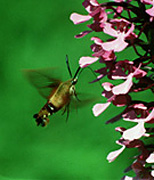Jeffrey R. Hapeman
Department of Botany
430 Lincoln Drive
Madison, WI 53706
Ph. 608/265-3348
FAX 608/262-7509
Email me at jhapeman@students.wisc.edu


Above is a photo of Hemaris thysbe (Sphingidae) pollinating Platanthera
peramoena, and a picture of me botanizing in Greene Prairie in the University
of Wisconsin Arboretum. For just a quick look at the barest of details,
you can see a stripped version of my CV.
Research on Platanthera
I am using molecular phylogenetic techniques to investigate the evolution
of floral morphology and associated pollination syndromes in the genus Platanthera
(Orchidaceae). Platanthera is the largest genus of north-temperate
terrestrial orchids; while circumscription of the genus is not exactly clear,
there are about 85 species found in North America, Asia, Europe and Borneo.
The largest centers of diversity are in North America (about 35 species)
and E. Asia (about 25 species).
What most interests me about the genus is the tremendous diversity of floral
syndromes and related pollination syndromes. Species are pollinated by bees,
flies, mosquitoes, butterflies, moths (both diurnal and nocturnal) and even
beetles! The flowers exhibit a host of morphological specializations relating
to pollination. My current research is an investigation of how these specializations
and pollination syndromes have evolved. Since most of the taxonomy of Platanthera
is based on floral features (as is the case for most of the Orchidaceae),
I needed an independent set of characters to infer the phylogeny; using
the floral morphological features would run the risk of character bias.
The molecular data is also valuable because it provides a large number of
informative characters. Platanthera and related genera are fairly
uniform vegetatively, so without the floral characters a morphological data
set was inadequate.
I am currently sequencing several rapidly-evolving chloroplast introns,
and I have sequenced the internal transcribed spacer region (ITS) of nuclear
ribosomal DNA for about 60 taxa, including representatives of 15 outgroup
genera in the same tribe as Platanthera. I am collaborating in this
work with Dr. Ken Inoue, of Shinshu University in Japan.
Research on the Tribe Orchideae
I am collaborating with the Royal
Botanic Gardens, Kew on a project investigating generic relationships
in the Orchideae. While much is known about the biology of this tribe (many
of the genera are found in Europe), knowledge of the phylogeny is poor at
best. Our molecular data will provide the first clear look at intergeneric
relationships in this fascinating and diverse group of orchids.
Research on Lilium
As a side project, I have begun looking at floral evolution in the North
American Lilium. The North American species of this genus are believed
to be monophyletic, derived from an ancient trans-Behringian migration.
Detailed work on the pollination biology of these species was conducted
by Mark Skinner for his PhD thesis at Harvard. I am using ITS sequences
to place the floral and pollination data in a phylogenetic context. This
phylogeny will be compared to Mark's, which was derived from non-floral
morphological characters. The species have apparently diverged (in terms
of molecular divergence) very little, as both chloroplast sequencing and
restriction site analyses have found no variation. This is corroborated
by the ITS data, which shows very low levels of divergence.
Other Interests and Projects
I have been assisting in Tom Givnish's and Ken Sytsma's work on the Hawaiian
lobelioids. See that page for more information on that fascinating project.
I also have begun dabbling with symbiotic culture of several species of
Platanthera. I hope to one day see gardens graced by spires of purple
P. psycodes and P. peramoena, the air filled with hovering
hawkmoths!
A strong interest of mine is computers, particularly their use in phylogenetic
biology. Much if not all of phylogenetic biology relies on computer analyses;
this is especially true of molecular phylogenetics. While most of my current
expertise in this area is limited to program use, I have ported several
UNIX programs to the Macintosh, and I continue to educate myself in programming
and methods of phylogenetic reconstruction in the hopes of one day adding
to this important part of phylogenetic biology.
You can also visit an on-going online project of mine, the interactive
flora Orchids of Wisconsin. This
work currently contains keys to all of the taxa native to Wisconsin, and
a few that should be looked for in the state. There are images for nearly
all the taxa, and there will be range maps and access to the UW-Madison
herbarium records by the end of May. Descriptive information for the taxa
should be complete at this time as well.
Go to the Sytsma
Lab Home Page.
Last Updated: April 21, 1996 JH



